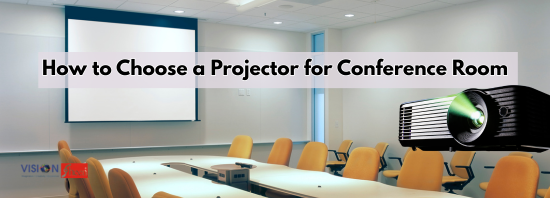The efficiency, professionalism, and clarity of corporate presentations can all be greatly impacted by the choice of a projector for conference room. A dependable projector guarantees that your message is seen clearly whether you’re holding client presentations, training sessions, or important meetings. With so many choices, it’s critical to comprehend the salient aspects and how they relate to your company’s requirements. This article will explain how to select a projector for a conference room that satisfies requirements for dependability, performance, and cost.
1. Understand the Size and Lighting of Your Conference Room
Room Size and Throw Distance
The size of the room will largely determine what type of projector you need:
- Small rooms (up to 10 feet throw distance): Consider a short-throw projector that delivers large images even at a close range.
- Medium to large rooms (15–30 feet): A standard-throw projector is typically suitable.
- Auditorium-style rooms: You may need long-throw or high-lumen projectors with advanced zoom features.
Ambient Lighting
The amount of light in your conference room affects image visibility:
- Bright rooms with natural light: Look for a projector with high brightness (3,500–6,000 lumens).
- Dim or controlled lighting: A projector with 2,500–3,500 lumens should suffice.
Always consider the lighting environment during daytime hours if your meetings typically happen then.
2. Focus on Resolution and Image Quality
The resolution impacts how clear and sharp your visuals appear:
- XGA (1024×768): Basic clarity for text and simple images. Suitable for budget-conscious buyers.
- WXGA (1280×800): Offers widescreen format, better for PowerPoint and video.
- Full HD (1920×1080): Recommended for professional business use with detailed charts, images, and videos.
- 4K UHD: Best for executive boardrooms, large screens, or when ultra-detailed visuals are a priority.
If you plan to project detailed presentations, videos, or graphs, prioritize at least Full HD.
3. Brightness: Lumens Matter
Brightness is measured in ANSI lumens, and it’s crucial in combating ambient light:
| Room Type | Recommended Lumens |
| Small/Dim Rooms | 2,500–3,500 lumens |
| Medium Rooms with Some Light | 3,500–5,000 lumens |
| Bright or Large Rooms | 5,000–6,500+ lumens |
For general conference room use, a projector with at least 3,500 lumens is ideal.
4. Connectivity Options
Modern conference rooms rely on diverse devices. Your projector should support multiple input options:
- HDMI: Standard for laptops and media players.
- USB: Plug-and-play presentations.
- VGA: Older compatibility, still used by some businesses.
- Wi-Fi / Wireless: For cable-free projection via laptops, tablets, or smartphones.
- Bluetooth: Useful for wireless speaker connectivity.
Also consider whether the projector supports screen mirroring or apps like Miracast, Chromecast, or AirPlay.
5. Consider the Type of Projector Technology
There are three main types of projector technologies:
- DLP (Digital Light Processing): Sharp images, reliable, good for video-heavy presentations.
- LCD (Liquid Crystal Display): Better color accuracy, great for static presentations like charts and spreadsheets.
- LED / Laser Projectors: Long lifespan, low maintenance, more eco-friendly but usually higher in price.
For frequent usage and long-term value, laser projectors are gaining popularity in business settings.
6. Audio Capabilities
If your conference room doesn’t have an external speaker setup, look for a projector with built-in speakers. While most built-in systems aren’t high fidelity, some models include decent 10W–20W speakers suitable for small to medium rooms. Alternatively, ensure the projector has audio out ports to connect external audio systems.
7. Portability vs. Installation
- Portable Projectors: Lightweight, easy to carry, ideal for mobile professionals or shared conference rooms.
- Ceiling-Mounted / Fixed Projectors: Better for dedicated rooms. Offers a cleaner look and permanent cable management.
If your conference room is used frequently, a permanently mounted projector with a remote-control system is more efficient.
8. Screen Compatibility and Aspect Ratio
Match your projector’s aspect ratio with your screen or display format:
- 4:3 (Standard): Older format, compatible with XGA resolution.
- 16:10 or 16:9 (Widescreen): Modern presentations and videos prefer this. Most Full HD or WXGA projectors use this ratio.
Make sure your projector matches your projection screen size and room layout to avoid distorted images.
9. User Interface and Ease of Use
Time is valuable in any business environment. Your projector should feature:
- Easy setup and keystone correction
- Quick input switching
- User-friendly menus
- Remote control or mobile app support
Consider auto-focus and zoom functions for added convenience.
10. Budget and Long-Term Maintenance
While budget is important, don’t sacrifice quality for short-term savings. Think long-term:
- Lamp life: Choose projectors with at least 10,000 hours lamp life.
- Warranty and support: Look for brands with strong after-sales support.
- Filter-free models: Reduce maintenance time and costs.
Laser and LED models have longer lifespans and lower maintenance, making them more cost-effective over time.
Recommended Projector Brands for Business Use
Some of the most trusted projector brands for conference rooms include:
- Epson
- BenQ
- Optoma
- ViewSonic
- Sony
- LG (for laser models)
These brands are known for their reliability, advanced features, and wide support for business needs.
Final Thoughts
Choosing a projector for your conference room isn’t just about image quality — it’s about enhancing communication, collaboration, and professionalism. Whether you’re pitching to clients, training staff, or leading strategy meetings, the right projector ensures your ideas are presented clearly and effectively. By assessing your room’s size, lighting, budget, and usage habits, you can confidently select a model that matches your unique business environment.


